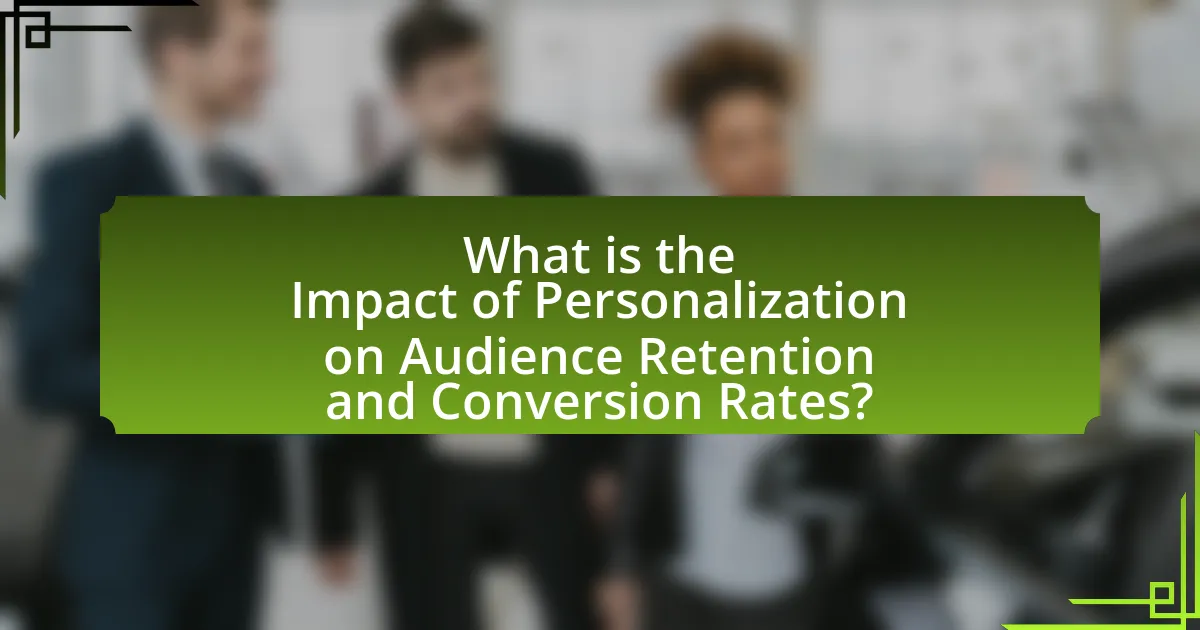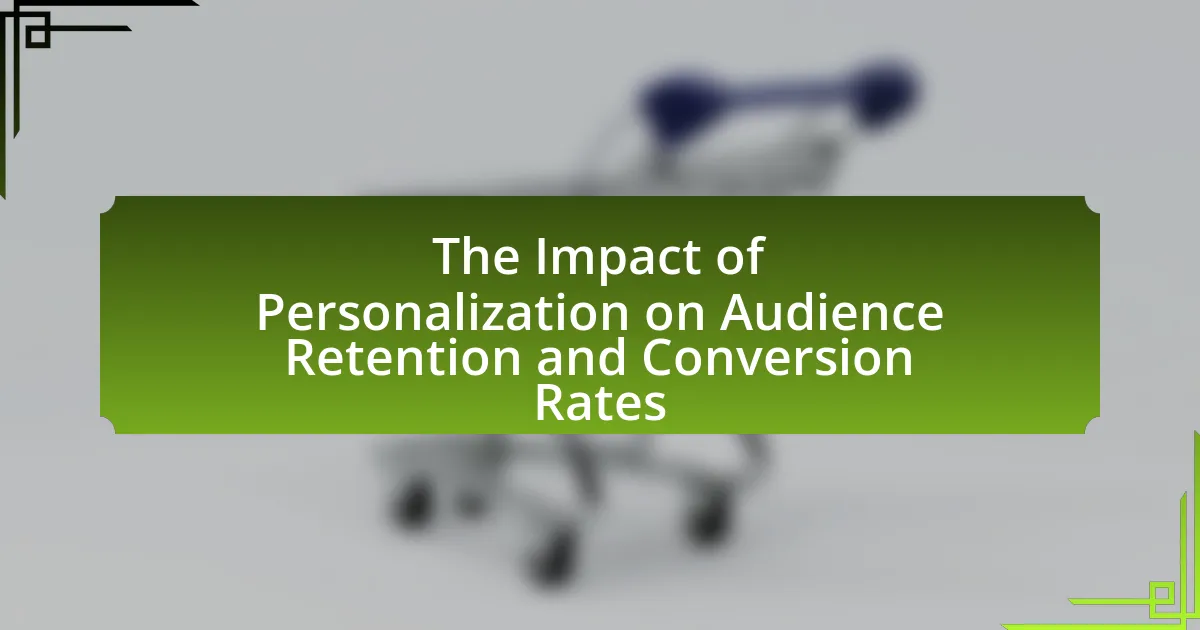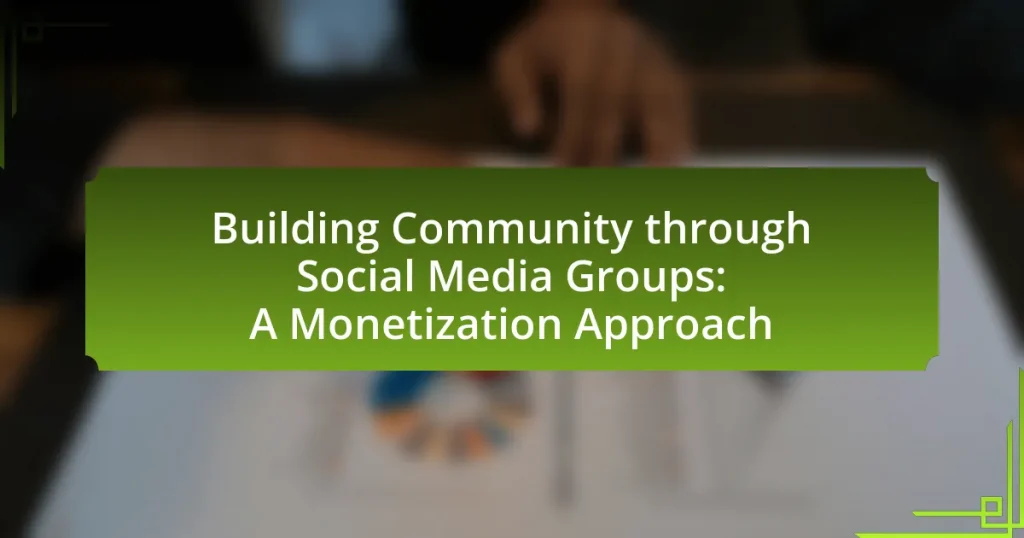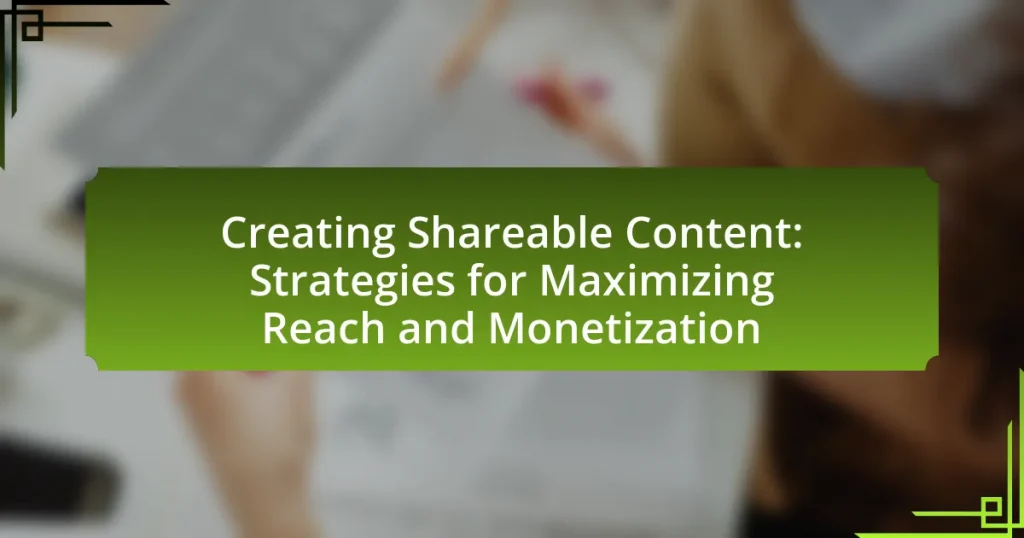The article examines the impact of personalization on audience retention and conversion rates, highlighting its significant role in enhancing customer engagement and loyalty. Research indicates that personalized experiences can lead to a 20% increase in sales and a 10% boost in customer retention, as consumers are more likely to engage with brands that tailor their offerings to individual preferences. Key elements influencing engagement include relevance, timing, and user experience, while audience segmentation further enhances personalization efforts. The article also discusses the importance of measuring audience retention and conversion rates, effective personalization strategies, and the challenges businesses face in implementing these strategies.

What is the Impact of Personalization on Audience Retention and Conversion Rates?
Personalization significantly enhances audience retention and conversion rates. Research indicates that personalized experiences can lead to a 20% increase in sales and a 10% boost in customer retention. For instance, a study by Epsilon found that 80% of consumers are more likely to make a purchase when brands offer personalized experiences. This correlation arises because personalization fosters a deeper connection between the brand and the consumer, making customers feel valued and understood, which in turn drives loyalty and increases the likelihood of repeat purchases.
How does personalization influence audience engagement?
Personalization significantly enhances audience engagement by tailoring content and experiences to individual preferences and behaviors. This targeted approach increases relevance, leading to higher interaction rates; for instance, studies show that personalized emails can generate up to six times higher transaction rates compared to non-personalized ones. Furthermore, personalization fosters a sense of connection and loyalty, as audiences feel understood and valued, which is evidenced by a report from Epsilon indicating that 80% of consumers are more likely to make a purchase when brands offer personalized experiences.
What are the key elements of personalization that affect engagement?
The key elements of personalization that affect engagement include relevance, timing, and user experience. Relevance ensures that content aligns with individual preferences and behaviors, which has been shown to increase user interaction; for instance, personalized recommendations can boost click-through rates by up to 300%. Timing refers to delivering personalized content at moments when users are most likely to engage, enhancing the likelihood of interaction. User experience encompasses the overall design and functionality tailored to individual needs, which can significantly improve satisfaction and retention rates. These elements collectively contribute to higher engagement levels by creating a more tailored and meaningful interaction for users.
How does audience segmentation enhance personalization efforts?
Audience segmentation enhances personalization efforts by allowing marketers to tailor messages and experiences to specific groups based on shared characteristics. This targeted approach increases engagement, as studies show that personalized content can lead to a 20% increase in sales (McKinsey & Company). By analyzing demographics, behaviors, and preferences, businesses can create more relevant and appealing interactions, ultimately improving customer satisfaction and loyalty.
Why is audience retention important for businesses?
Audience retention is crucial for businesses because it directly influences profitability and growth. High audience retention rates indicate that customers are satisfied and engaged, leading to increased lifetime value and reduced acquisition costs. According to a study by Bain & Company, a 5% increase in customer retention can lead to a profit increase of 25% to 95%. This demonstrates that retaining existing customers is often more cost-effective than acquiring new ones, making audience retention a key metric for sustainable business success.
What role does personalization play in improving audience loyalty?
Personalization significantly enhances audience loyalty by creating tailored experiences that resonate with individual preferences and behaviors. When brands utilize data-driven insights to customize content, products, and interactions, they foster a deeper emotional connection with their audience. Research indicates that 80% of consumers are more likely to make a purchase when brands offer personalized experiences, demonstrating that personalization not only attracts but also retains customers. This tailored approach leads to increased satisfaction and trust, which are critical components of long-term loyalty.
How can businesses measure audience retention effectively?
Businesses can measure audience retention effectively by analyzing metrics such as customer lifetime value (CLV), repeat purchase rate, and engagement rates across various channels. These metrics provide insights into how often customers return and interact with the brand. For instance, a study by Adobe found that personalized experiences can increase customer retention rates by up to 30%, highlighting the importance of tailored content in keeping audiences engaged. Additionally, tools like Google Analytics can track user behavior over time, allowing businesses to assess retention trends and make data-driven decisions to enhance customer loyalty.
What are the conversion rates and why do they matter?
Conversion rates are the percentage of users who take a desired action, such as making a purchase or signing up for a newsletter, out of the total number of visitors. They matter because they directly indicate the effectiveness of marketing strategies and the overall performance of a business. For instance, a higher conversion rate signifies that a larger proportion of visitors are engaging with the content or products, which can lead to increased revenue and customer loyalty. According to a study by WordStream, the average conversion rate across industries is about 2.35%, with the top 25% of companies achieving conversion rates of 5.31% or higher, highlighting the importance of optimizing conversion strategies to improve business outcomes.
How does personalization impact conversion rates?
Personalization significantly enhances conversion rates by tailoring experiences to individual user preferences and behaviors. Research indicates that personalized marketing can lead to a 20% increase in sales, as consumers are more likely to engage with content that resonates with their specific interests. For instance, a study by Epsilon found that 80% of consumers are more likely to make a purchase when brands offer personalized experiences. This demonstrates that effective personalization not only captures attention but also drives higher engagement and ultimately boosts conversion rates.
What metrics should be used to evaluate conversion success?
To evaluate conversion success, key metrics include conversion rate, average order value, customer acquisition cost, and return on investment. The conversion rate measures the percentage of visitors who complete a desired action, providing insight into the effectiveness of marketing strategies. Average order value indicates the average amount spent per transaction, which helps assess revenue generation. Customer acquisition cost reflects the total cost of acquiring a new customer, allowing businesses to evaluate the efficiency of their marketing efforts. Return on investment quantifies the profitability of marketing campaigns by comparing the revenue generated to the costs incurred. These metrics collectively provide a comprehensive view of conversion success and inform strategic decisions.
How can businesses implement effective personalization strategies?
Businesses can implement effective personalization strategies by leveraging data analytics to understand customer preferences and behaviors. By collecting and analyzing data from various touchpoints, such as website interactions, purchase history, and social media engagement, businesses can create tailored experiences that resonate with individual customers. For instance, a study by McKinsey & Company found that personalized marketing can lead to a 10-30% increase in revenue, demonstrating the financial benefits of targeted strategies. Additionally, utilizing machine learning algorithms can enhance the accuracy of personalization efforts, allowing businesses to predict customer needs and deliver relevant content or product recommendations in real-time.
What challenges do businesses face in personalizing their audience experience?
Businesses face several challenges in personalizing their audience experience, primarily due to data privacy concerns, technological limitations, and resource constraints. Data privacy regulations, such as the General Data Protection Regulation (GDPR), restrict how businesses can collect and use customer data, making it difficult to create tailored experiences. Technological limitations arise from the need for advanced analytics and machine learning capabilities to process large datasets effectively, which many businesses may lack. Additionally, resource constraints, including budget and personnel, hinder the ability to implement and maintain personalized strategies. According to a survey by Epsilon, 80% of consumers are more likely to make a purchase when brands offer personalized experiences, highlighting the importance of overcoming these challenges for improved audience retention and conversion rates.
What best practices can enhance personalization for better retention and conversion?
To enhance personalization for better retention and conversion, businesses should implement data-driven segmentation, utilize dynamic content, and leverage behavioral triggers. Data-driven segmentation allows companies to categorize their audience based on demographics, preferences, and past interactions, leading to tailored marketing strategies that resonate with specific groups. For instance, a study by McKinsey found that personalized experiences can lead to a 10-15% increase in conversion rates. Dynamic content, which adapts based on user behavior and preferences, ensures that customers receive relevant information, thereby increasing engagement and retention. Additionally, leveraging behavioral triggers, such as sending personalized emails based on user actions, can significantly improve conversion rates; research indicates that triggered emails have a 152% higher open rate compared to standard emails. These best practices collectively create a more engaging and relevant experience for users, ultimately driving retention and conversion.
How can data analytics improve personalization efforts?
Data analytics can significantly enhance personalization efforts by enabling businesses to analyze customer behavior and preferences in real-time. By leveraging data analytics tools, companies can segment their audience based on various metrics such as purchase history, browsing behavior, and demographic information. This segmentation allows for tailored marketing strategies that resonate with specific customer groups, leading to higher engagement rates. For instance, a study by McKinsey & Company found that personalized marketing can lead to a 10-30% increase in revenue, demonstrating the effectiveness of data-driven personalization. Additionally, data analytics facilitates continuous optimization of personalization strategies by providing insights into what works and what doesn’t, allowing businesses to adapt quickly to changing customer needs.
What tools are available for effective personalization implementation?
Effective personalization implementation can be achieved using tools such as customer relationship management (CRM) systems, data analytics platforms, and marketing automation software. CRM systems like Salesforce enable businesses to gather and analyze customer data, allowing for tailored marketing strategies. Data analytics platforms, such as Google Analytics, provide insights into user behavior, which can inform personalized content delivery. Marketing automation tools, like HubSpot, facilitate the segmentation of audiences and the automation of personalized communication, enhancing engagement and conversion rates. These tools collectively support the creation of personalized experiences that drive audience retention and improve conversion metrics.



